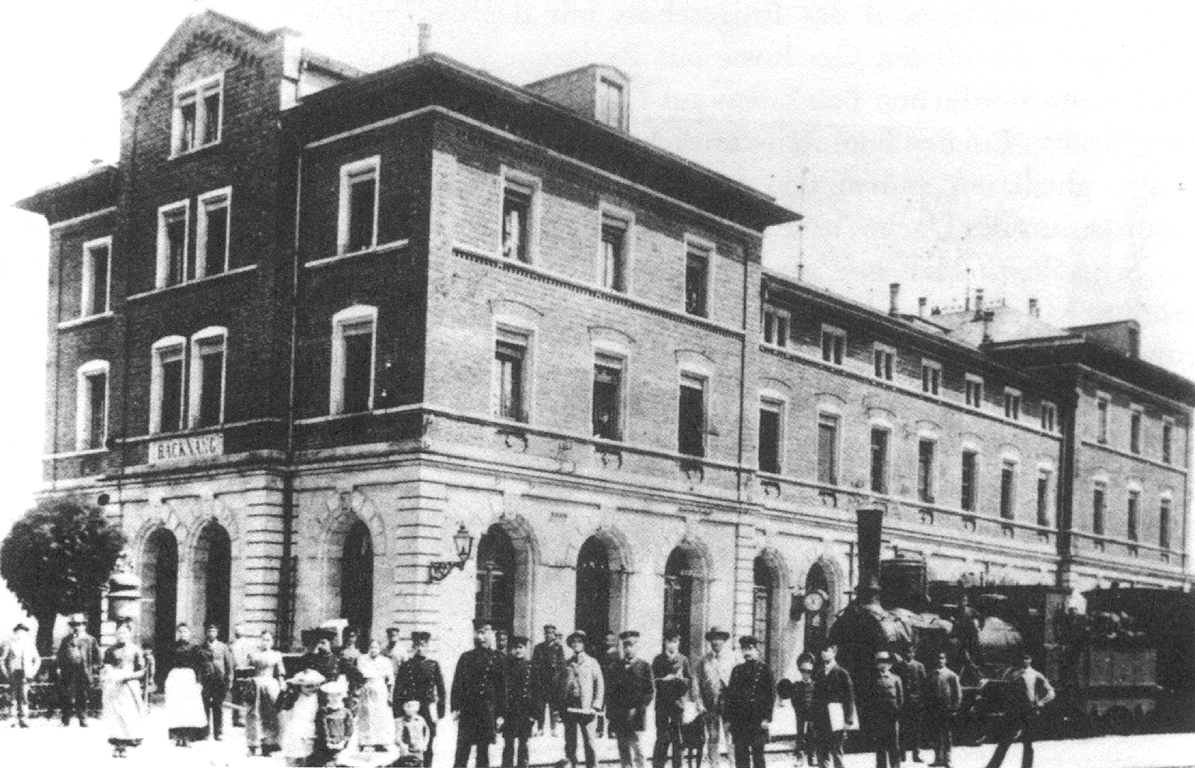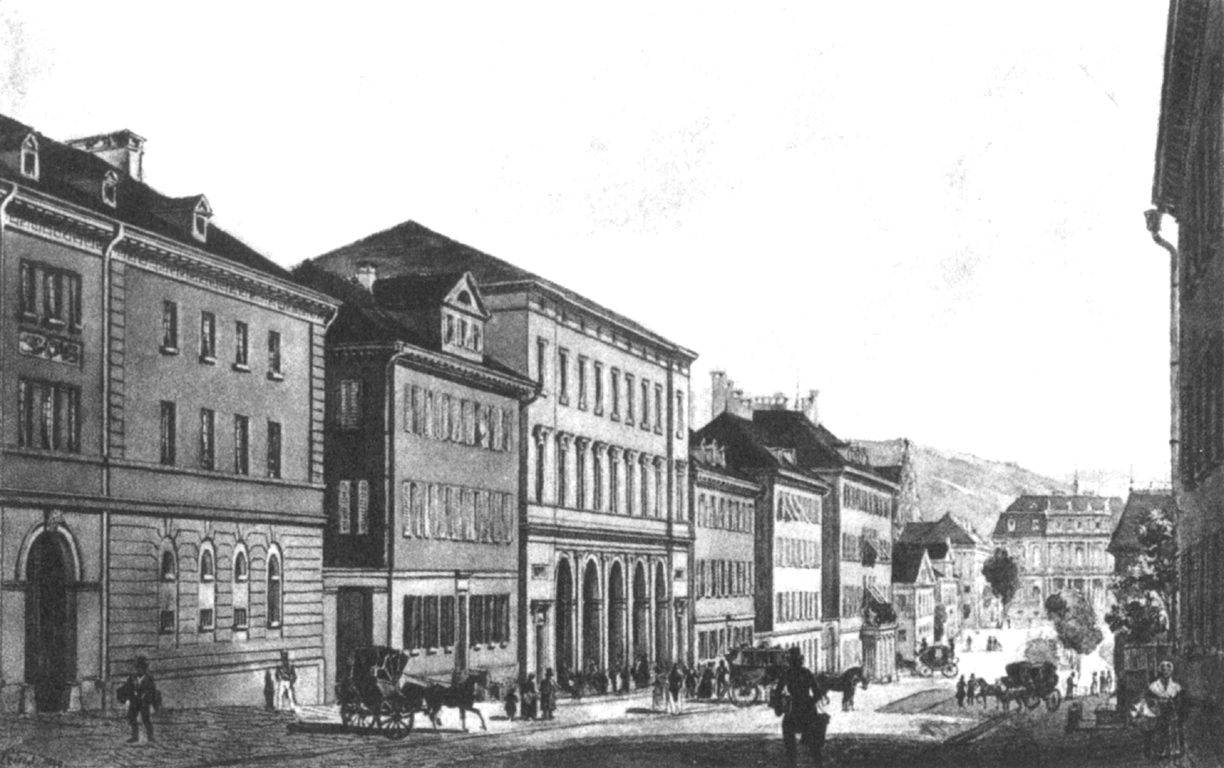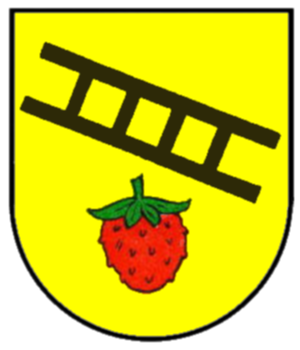|
Backnang Station
Backnang station is located on the Waiblingen–Schwäbisch Hall railway and is the starting point of the Backnang–Ludwigsburg railway in the city of Backnang in the German state of Baden-Württemberg. It is served by Regional-Express services. It is the terminus of lines S 3 and S 4 of the Stuttgart S-Bahn. It is classified by Deutsche Bahn as a category 3 station. History In the 1860s, the citizens of the Oberamt (district) of Backnang sought a connection to the rail network. In 1863, the Backnang trade association, together with trade associations in other towns, wrote a petition to the Württemberg ministry of foreign affairs, which was then in charge of railway construction. By the autumn engineers had travelled to the area to make surveys. State Railways and Deutsche Reichsbahn periods On 26 October 1876, the Royal Württemberg State Railways (german: Königlich Württembergischen Staats-Eisenbahnen) opened the Murr Valley Railway between Waiblingen and Backnang. The ... [...More Info...] [...Related Items...] OR: [Wikipedia] [Google] [Baidu] |
Backnang
Backnang (; swg, Bagene) is a town in Germany in the Bundesland of Baden-Württemberg, roughly northeast of Stuttgart. Its population has increased greatly over the past century, from 7,650 in 1900 to 35,761 in 2005. Backnang was ceded to Württemberg by the Baden ( Zähringer family) in 1325. Backnang has been known as ''Gerberstadt'' due to several tanneries and leather factories, and wool and cloth mills that dominated Backnang's industries. Today, all of these have vanished, and instead, telecommunication companies such as Ericsson (formerly AEG, Telefunken, ANT Nachrichtentechnik, Bosch and Marconi) and Tesat-Spacecom dominate the town's industries. The ''Stiftskirche'', formerly the church of Backnang Abbey, dates back to the 12th century. Backnang hosts the annual ''Strassenfest'' during the last weekend in June. It has been founded as a street festival where local sports and cultural clubs offered drinks and foods. The traditional opening of the ''Strassenfest'' ... [...More Info...] [...Related Items...] OR: [Wikipedia] [Google] [Baidu] |
Murr (river)
The Murr () is a river in Baden-Württemberg, Germany, right tributary of the Neckar. The river gave its name to a small town on its banks, Murr, and to the Rems-Murr-Kreis district, which was also named after the river Rems, which runs roughly parallel to the south of the Murr. Its source is approx. 4 km south of Murrhardt. It flows northeast before turning west to cross Murrhardt. After a further 7 km, Sulzbach an der Murr is reached. Here, at its northernmost point, the Lauter joins from the north, coming from Spiegelberg. The Murr continues southwest, passing Oppenweiler to reach Backnang, where its narrow valley widens. Further towns on its way are Burgstall an der Murr, Kirchberg an der Murr, Steinheim an der Murr, and the community of Murr itself, which is located in the district of Ludwigsburg. North of Marbach am Neckar, the Murr joins the Neckar after having travelled about 50 km in total. The Murr runs south of the Löwenstein Hills. A large part o ... [...More Info...] [...Related Items...] OR: [Wikipedia] [Google] [Baidu] |
Stuttgart Flughafen/Messe Station
Stuttgart Flughafen/Messe (German for Stuttgart Airport/Trade Fair) station is a station on the network of the Stuttgart S-Bahn. Despite its name the station is not in the city of Stuttgart, rather it is in Leinfelden-Echterdingen. History The draft plans for the construction of an S-Bahn system in the Stuttgart area in the 1960s included consideration of a connection to the Filder plain. The line from Stuttgart-Rohr to Neuhausen auf den Fildern, on which passenger services had been closed in 1955 would be upgraded to enable S-Bahn operations to Stuttgart airport. However, the provision of better public transport links to the airport at that time was not considered a priority and had no urgency. The doubling and electrification of the Stuttgart-Rohr–Echterdingen line only began in 1984. The connection to the airport from Echterdingen used a completely new route. The lack of space at the airport meant that only an underground station was considered. In 1986, work began on conn ... [...More Info...] [...Related Items...] OR: [Wikipedia] [Google] [Baidu] |
Stuttgart-Rohr Station
Rohr station is located the chainage of 16.7 km (from Stuttgart Hauptbahnhof via the old route) on the Gäu Railway (german: Gäubahn) and is a station in the network of the Stuttgart S-Bahn. History When the Royal Württemberg State Railways opened the Gäu Railway from Stuttgart to Freudenstadt in September 1879, many residents of Rohr saw only the drawbacks of the new system of transport. Some farmers had been dispossessed for the line and believed the railway would bring only noise and odours. But when industrialisation began in the neighbouring village of Vaihingen and commuters from Rohr took advantage of its station, people learned of rail's advantages. In 1906, Rohr station opened for passenger services. The station building was a one-story brick building with a waiting-room and station services on the former platform 1, which served the line towards Böblingen. The line to Echterdingen has branched off 600 metres south of the station since October 1920. In 1935 ... [...More Info...] [...Related Items...] OR: [Wikipedia] [Google] [Baidu] |
Stuttgart-Vaihingen Station
Vaihingen station is located on the Gäu Railway (german: Gäu bahn) in the German state of Baden-Württemberg. It is served by regional services and Stuttgart S-Bahn lines S1, S2 and S3. It is also a hub for public transport to the Filder plain. History The Royal Württemberg State Railways opened the Gäu Railway from Stuttgart to Freudenstadt together with Vaihingen auf den Fildern station on 2 September 1879. This was then about 400 metres southeast of Vaihingen village and consisted of the existing entrance building and a freight terminal building. In 1891, the Filder Railway Company (''Filderbahn-Gesellschaft'') decided to establish a line from Möhringen to Vaihingen station, which was approved by the government on 14 April 1896. The first train ran to Vaihingen on 23 December 1897. The metre gauge tracks were to the east of the State Railways’ standard gauge tracks. In 1898 a Rollbock facility was built at the station to enable standard gauge freight wagons to be tra ... [...More Info...] [...Related Items...] OR: [Wikipedia] [Google] [Baidu] |
Stuttgart Central Station
Stuttgart Hauptbahnhof (; en, Stuttgart central station) is the primary railway station in the city of Stuttgart, the state capital of Baden-Württemberg, in southwestern Germany. It is the largest regional and long-distance railway station in Stuttgart, the main node of the Stuttgart S-Bahn network, and, together with the station at Charlottenplatz, it is the main node of the Stuttgart Stadtbahn. Located at the northeastern end of the ''Königstraße'', the main pedestrian zone of the city centre, the main line station is a terminus, whilst the subterranean S-Bahn and Stadtbahn stations are through-stations. The station is well known for its 12-storey tower with a large, rotating and illuminated Mercedes-Benz star insignia on top; the tower and station building are city landmarks. Plans for the controversial Stuttgart 21 project to convert the main line terminus station into an underground through station include the demolition of the side wings of the building, together wi ... [...More Info...] [...Related Items...] OR: [Wikipedia] [Google] [Baidu] |
Winnenden
Winnenden ( Swabian: ''Wẽnnede'') is a small town in the Rems-Murr district of the Stuttgart Region in Baden-Württemberg in southwest Germany. It lies in a wine-growing area approx. northeast of Stuttgart and has a population of fewer than 28,000. The town is home to the Kärcher Company, makers of cleaning equipment namely pressure washers. History The earliest record of Winnenden is found in a document of 1181 where Gottfried of Schauenburg-Winnenden is mentioned as a witness testifying that Emperor Friedrich I held the castle in the town. Around 1200 the castle, which was then called Windin, came into the possession of Heinrich of Neuffen. In 1277 it was transferred to Konrad von Weinsberg. On 10 October 1325 the castle and town were sold to Württemberg. In the German Peasants' War Winnenden was first under the control of the Armer Konrad or the peasants' army, but by 1519 it was under the control of the Swabian League. In 1616 an epidemic took the lives of approximat ... [...More Info...] [...Related Items...] OR: [Wikipedia] [Google] [Baidu] |
Nürnberg Hauptbahnhof
Nürnberg Hauptbahnhof (German for ''Nuremberg main station'') or Nuremberg Central Station''The train to the plane'' at www.lufthansa.com. Accessed on 7 Oct 2013 at www.dbmuseum.de. Accessed on 7 Oct 2013 is the main railway station serving the city of in . It is the largest station in north |
Ansbach Station
Ansbach station is the central transportation hub in the town of Ansbach in southern Germany. It is here that two main lines cross: the Nürnberg–Crailsheim and Treuchtlingen–Würzburg railways. History Ansbach was first connected to the railway network by a leased railway, that linked the town to the Ludwig South-North Railway at Gunzenhausen 28 kilometres away and which was opened on 1 July 1859. In 1869, the railway was open all the way from Würzburg to Treuchtlingen and, in 1875, it was joined by the line from Nuremberg, which was extended over the state border to Crailsheim in 1876. In 1903, the Leutershausen-Wiedersbach–Bechhofen railway was opened, whose trains were nicknamed ''Boggala'' in the Bechhofen dialect, and usually ran through to Ansbach. However it was closed as early as 28 November 1966. With the establishment of the Nuremberg Regional Transport Union (''Verkehrsverbund Großraum Nürnberg'' or ''VGN'') the line to Nuremberg was integrated ... [...More Info...] [...Related Items...] OR: [Wikipedia] [Google] [Baidu] |
Stuttgart-Bad Cannstatt Station
Bad Cannstatt station is the second largest station of the German city of Stuttgart after Stuttgart Hauptbahnhof and has eight platform tracks. Together with Untertürkheim station, it is the oldest station in Württemberg. History During the planning of the original railway in Württemberg, the Württemberg Central Railway (german: Württembergische Centralbahn), it was proposed to provide a station for the city of Cannstatt with its 5,500 inhabitants. The original proposal for the line consisted of a connection between the proposed Stuttgart Central Station to Cannstatt, where it would branch towards Esslingen and Ludwigsburg. Because of Stuttgart's geographical location, the route via Cannstatt was the only feasible route for a railway with the technology of the time. On 5 October 1845, the first railway in Württemberg was opened from Cannstatt to Untertürkheim. Following the completion of the Rosenstein Tunnel on 4 July 1846, the first train ran into Stuttgart station on ... [...More Info...] [...Related Items...] OR: [Wikipedia] [Google] [Baidu] |
Stuttgart Hauptbahnhof
Stuttgart Hauptbahnhof (; en, Stuttgart central station) is the primary railway station in the city of Stuttgart, the state capital of Baden-Württemberg, in southwestern Germany. It is the largest regional and long-distance railway station in Stuttgart, the main node of the Stuttgart S-Bahn network, and, together with the station at Charlottenplatz, it is the main node of the Stuttgart Stadtbahn. Located at the northeastern end of the ''Königstraße'', the main pedestrian zone of the city centre, the main line station is a terminus, whilst the subterranean S-Bahn and Stadtbahn stations are through-stations. The station is well known for its 12-storey tower with a large, rotating and illuminated Mercedes-Benz star insignia on top; the tower and station building are city landmarks. Plans for the controversial Stuttgart 21 project to convert the main line terminus station into an underground through station include the demolition of the side wings of the building, together with ... [...More Info...] [...Related Items...] OR: [Wikipedia] [Google] [Baidu] |
Marbach (Neckar) Station
Marbach (Neckar) station serves the town of Marbach in the German state of Baden-Württemberg. It is the terminus for line S 4 of the Stuttgart S-Bahn and Regionalbahn trains from Backnang. Until 1966, this was the starting point of the Bottwar Valley Railway (''Bottwartalbahn''), which ran all the way to Heilbronn Süd station. History The Backnang–Bietigheim line was built by the Royal Württemberg State Railways as part of a new east–west link from the Bavarian border at Crailsheim to the Baden border at Mühlacker. The town council of Marbach had long petitioned the government for a connection to the railway network, which the new line would provide. Construction began in 1875. A huge iron truss viaduct with sandstone pillars was built over the Neckar valley between Marbach and Benningen. The station was built about half a kilometre northeast of the centre of the town. The station building, which is still preserved, was more impressive than the others on the line. The c ... [...More Info...] [...Related Items...] OR: [Wikipedia] [Google] [Baidu] |






